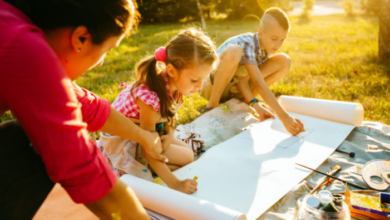How Distance Learning Taught Me Three Lessons

Teachers are role models and inspirations. When educators were asked to fast shift from traditional teaching to remote learning just a year ago, no one could have predicted what would happen.
In just a few days, school districts across California had figured out how to retrieve students’ electronics, food, and supplies. Parents become more appreciative of what teachers accomplish every day as a result of teachers’ adoption of new technology. (It’s also given us a newfound respect for them.) Caretakers were essential to a lot of what was accomplished.)
Now is the moment to follow in the footsteps of successful educators and do what they do. It’s important to reflect on what we’ve learnt in order to recognise obstacles and devise ways around them. Distant learning experiences of spring 2020 are being replaced by more intentional and integrated approaches that restore the rigour that was momentarily compromised in the face of a crisis..
Even though there are still many unanswered questions, we are better prepared to anticipate issues and take proactive measures to deal with them as they arise. Each of the nation’s 14,000 school districts has its own unique reopening plan, which must be addressed in the context of the local community.
We can, however, anticipate the presence of some type of distance learning. Full, partial or intermittent access is possible. What matters is that we put the knowledge and skills we’ve gained from research and practice to good use as we get ready for the 2020-21 academic year.
LESSON #1: DO NOT TRY TO FIX THE ISSUE.
The “COVID decline” has been widely discussed as a result of the difficulty in reaching all students with effective teaching. These worries are well-founded, to be sure. Health care disparities, housing instability, access to technology, and varied support for English learners and children with impairments are exacerbated by the epidemic, according to the Alliance for Resource Equity (2020) and the Education Trust.
The same diagnostic tool that has been used successfully after disasters to identify what students know and don’t know (not just what we think they might not know) and triage to increase precision and accelerate learning is one of the most important educational tools we have at our disposal as educators.
Hurricane Katrina, the Christchurch earthquakes, the Australian bush fires and a fireworks factory explosion all led to identical outcomes when it came to post-earthquake learning (Fisher, Frey, & Hattie, 2020). Many of these students’ test scores fell when the diagnosis-instruction-assessment cycle was broken once they returned to traditional schooling. This is an interesting finding.
Literacy assessment techniques that provide detailed information about the reader or writer rather than relying exclusively on a single measure, such as a numerical or letter score, are preferable. Surveys of phonics, vocabulary, and analytic writing samples, for example, suggest where more teaching is required. Students’ needs must be assessed from the beginning of the school year in order to determine what they will require in the future.
Then, using research-based methods like those in the Visible Learning database, teach precisely to close those knowledge gaps. Another benefit of live teaching during remote learning has been that small-group needs-based guided instruction is considerably more valuable than lectures. If you want to allow students to refer back to recorded asynchronous viewings, keep these around.
Even when you have the opportunity to teach in person, maintain a blended learning approach so that students can get direct education online on a regular basis. Take advantage of the extra time you’ll have to devote to coaching and guiding the guided learning process. This is the time of day when you are most productive as a teacher.
LEARNING VOLUME #2
Another major cause for concern is the recent drop in pupils’ reading volume. Students improve their reading comprehension by focusing their attention on the page. Elementary pupils who were taught by excellent instructors spent much more time reading, according to research by Allington (2002).
The phrase “reading instruction” was omitted. In comparison, the average class spends less than 20 minutes a day reading. Students should be reading for roughly 90 minutes a day, on average. Many youngsters may not have been able to maintain a high level of reading if they had not been in school, which provides structure.
Every day of reading should be part of a well-rounded distant learning strategy going ahead. Students can be required to complete readings ahead of time, or they can read portions aloud in class. The ABCD model (Fisher & Frey, 2018) is a good fit for our research on reading volume.
- Digital readings will make information more widely available.
- Using book discussions, you can introduce your pupils to a new book every day.
- Text sets allow students to select readings, and theme text sets allow students to select readings.
- Organize book clubs and literature circles to facilitate debate.
It is essential to have a solid foundation of knowledge in order to do well in school and in the workforce. Students who read more have a broader understanding of the natural, biological, and social environments in which they live. The following four strategies should be included in the lesson plans of all teachers of literacy who use remote learning. We are putting an increasing number of children in danger of not benefiting from their education if we do not pay attention to reading volume.
INFUSE SOCIAL AND EMOTIONAL LEARNING INTO THE PROCESS
Physically separating ourselves from our pupils brought home to us just how critical social-emotional learning (SEL) is in the educational setting. The texts we choose for the next school year will be critical in bridging the gap between SEL and academic learning that has long existed. Use texts that highlight SEL topics to analyse how fictional and real-life characters deal with conflicting values and moral challenges.
A Bike Like Sergio’s (Boelts, 2016) explores the conflict between economic hardship and ethical duty among first-graders. Children from all across the world conduct nine acts of social justice in the middle-grade novel Sit (Ellis, 2018). Informational content for secondary school students on how to take action and learn about the history of systemic racism is provided in Stamped: Racism, Anti-Racism, and You (Reynolds & Kendi, 2019).
Among the various texts that promote debate and writing about issues that energise and empower youngsters, these three are only a few of the many.
Link social and emotional learning concepts to real-world activities. Writing letters to elected officials about social injustice is an option for students. For example, they can start a home garden or set up a recycling station for the benefit of their family.
During each live session, you can offer daily emotional check-ins for younger children to help them understand their feelings (face-to-face and virtual). Each week, they can practise cognitive self-regulation by establishing goals and tracking their progress toward accomplishing them.
However, none of this is likely to occur unless we make preparations for it in before. SEL principles taught in the classroom must be used in the same manner as academic standards, and they must be visible, present, and utilised in every lesson.



